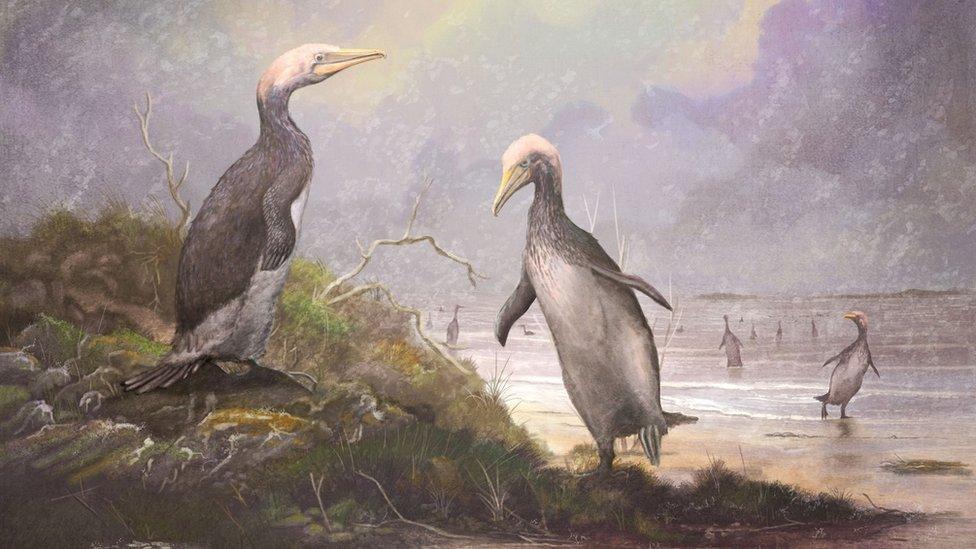Huge penguin-like birds lived in several countries millions of years ago
- Published
- comments

This is what Plotopterids might have looked like
Amazing fossil discoveries, made several years ago, revealed some ancient penguins were as big as grown men.
The species, nicknamed 'Kumimanu', meaning 'monster bird', inhabited New Zealand.
Now, palaeontologists have discovered that similar large birds also lived in Japan, the USA and Canada.
The creatures have been named Plotopterids and they may help scientists find out why some birds develop the ability to swim, and not fly.
What are Plotopterids?
Experts believe that the first penguin species swam in tropical seas around land that is now New Zealand, which sits in the Earth's southern hemisphere.
By unearthing the fossilised bones of penguins that lived there 62 million years ago, experts have been able to recognise nine different species of the first penguins.
Some were small like the Yellow-Eyed penguin, but some - the Waimanu, Muriwaimanu and Sequiwaimanu species - were around 1.6 metres tall, much bigger than any penguin that lives today.
The Waimanu, Muriwaimanu and Sequiwaimanu species were around 1.6 metres tall
But now similar fossil discoveries have been made in the Northern Hemisphere, which have unveiled a different type of bird, one that is even bigger than those found in New Zealand.
Plotopterids could grow to over two metres long and are believed to have looked just like a penguin.
They are thought to have had penguin-like long beaks with 'slit-like nostrils, similar chest and shoulder bones, and similar wings', making them strong swimmers and great at catching underwater prey.
'Monster' penguin fossils are on display in New Zealand
But the strange things is, even though they may have looked the same, experts have discovered that Plotopterids are not actually penguins at all, they evolved much later, between 34 and 37 million years ago.
"Plotopterids looked like penguins, they swam like penguins, they probably ate like penguins - but they weren't penguins." said Dr Paul Scofield, from the Canterbury Museum in New Zealand.
"These birds evolved in different hemispheres, millions of years apart, but from a distance you would be hard pressed to tell them apart," he added.
What could this new discovery mean?
The discovery is interesting because it might help experts understand more about evolution, and what caused some birds to start swimming, instead of flying.
"This is an example of what we call convergent evolution," said Dr De Pietri from the Canterbury Museum.
This is when creatures develop similar features because of having to adapt to similar environments, even though this could happen millions of years apart or in different parts of the world.
"What's remarkable about all this is that Plotopterids and ancient penguins evolved these shared features independently," said Dr Pietri.
The study has been published in the Journal of Zoological Systematics and Evolutionary Research.
- Published14 December 2017
- Published23 February 2017
- Published27 February 2012
